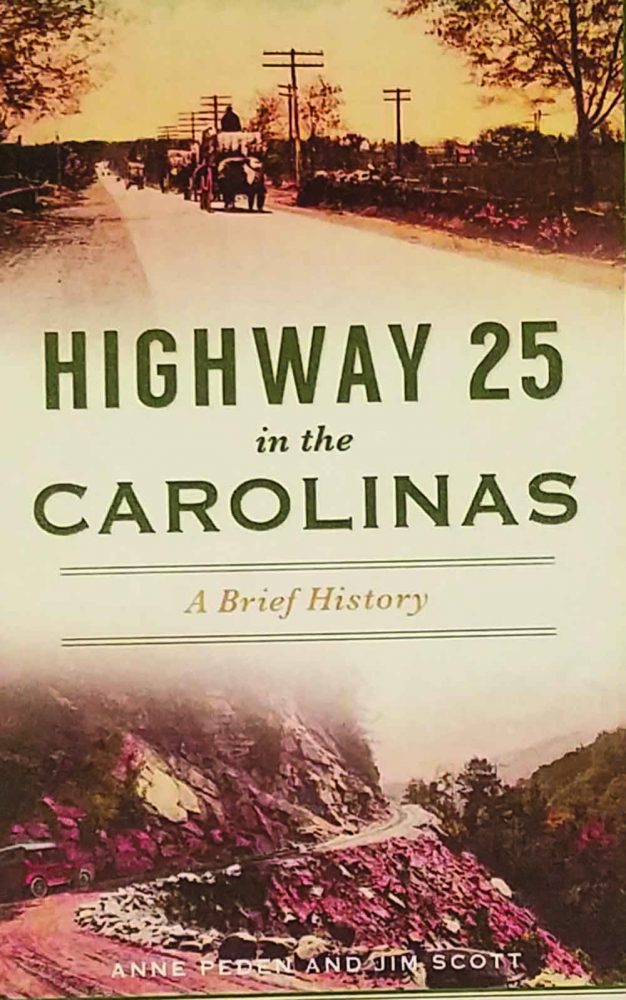Highway 25 in the Carolinas: A Brief History by Anne Peden and Jim Scott has a publication date of March 8th, 2021, from the History Press.
Our book started with the work to nominate this historic road to become the third road in the state of South Carolina to be recognized by the National Park Service. There is one in Charleston and one in York. US Highway 25 began as a bison path, a Native American trade path, and then a wagon road to Augusta, Georgia, the closest navigable waterway to the Atlantic Ocean from Tennessee and Kentucky, Western North Carolina, and the West.
Mainly pelt trade increased the use of the path even prior to the Revolution, and afterward when animals were mostly depleted, it became a wagon road to move farming products to the sea. The Road to Hamburg, a port on the South Carolina side of the Savannah River across from Augusta, was not only a wagon road but a drover’s trail from Kentucky through Tennessee and North Carolina going along the French Broad River to the Saluda Gap into South Carolina at the state line near Tuxedo. Traveling through northern Greenville County’s Dark Corner, the road passed on to Traveler’s Rest before coming to the “Mountain Town” of Greenville and then following the road we now know to Augusta.
Low Country planters began coming up the road by 1820 to resorts and then came industry from the Augusta area where the first large, successful cotton mill was built at Graniteville in the 1840s. Three historic inns from the early 1800s still exist along this trail in Greenville County, the Goodwin House at US 25 and Hwy. 11 owned by Greenville County Recreation Department, Spring Park Inn in Travelers Rest owned by Travelers Rest Historical Society, and McCullough’s Cedarhurst near Princeton owned by Fork Shoals Historical Society. Plans are for the three groups to open these sites to the public when restoration is complete. Funding is needed for all three.
In the early 1900s the Good Roads Movement across the country was initiated by bicycle and motorcycle enthusiasts and quickly transferred to the growing automobile industry. Roads began to be paved with macadam and concrete, and national roads were named across the country moving travelers north to south and east to west across numerous states. One of those named roads was the Dixie Highway designed to entice motorists from Chicago and Detroit to Miami. This road evolved to include several routes with the Carolina Division formed in 1918 bringing northerners through the Carolinas and building on the Western Carolina tourist industry. The efforts and planning for this road supported the later development of President Eisenhour’s Interstate Highway system.
Highway 25 in the Carolinas combines the history of the dirt road and the paved road and provides a travel guide for motorists to retrace these two paths following the feet and wheels of hundreds of thousands of travelers (human and animal) over three centuries.
National Register Nomination for US 25 in South Carolina by Anne Peden and Jim Scott will be presented to the State Historic Preservation Office in March, 2021.
For an application for a road, the National Register requires that the original roadbed still be in existence. So, Jim and I had to find all the original road sections that were left from state line to state line. Some sections are still in use and some are abandoned. We spent days tracing old maps and maps on google, slowly driving the roads looking into the woods, and finding shadowy dirt paths worn into the landscape. We found places where the drover’s road diverged from the paved road. We found concrete with weeds growing in the expansion joints and concrete worn down to the rocks. We found towns that no longer exist and towns that grew and then waned in importance and finally disappeared. We interviewed historians and folks we saw along the way. We visited museums, parks, and book stores. This was a fantastic road trip!
Finally, the State Historic Preservation Office recommended we use the paved sections of concrete that are extant for the application, then they gave me writing guidance, and the final document is well over 50 pages. In March Jim and I will present this history of US 25 to the state committee for possible approval, which will allow it to be sent on to the National Park Service for final recognition. Wish us luck!
The profits from the sale of Highway 25 in the Carolinas will go to the restoration of the McCullough’s Cedarhurst, Fork Shoals Historical Society’s 1812 brick home on US 25 near Princeton in southern Greenville County. Look for opportunities to purchase copies after March 8th. And Jim and I will be glad to share this important history of the growth of the northwestern part of South Carolina for programs at club meetings. Contact us at acpeden07@gmail.com. To reserve signed copies for @21.99, use the same email. Thanks for your support!
Anne Peden, Phd.
Greenville County Historic Preservation Commission
Fork Shoals Historical Society
Piedmont Historical Preservation Society■


